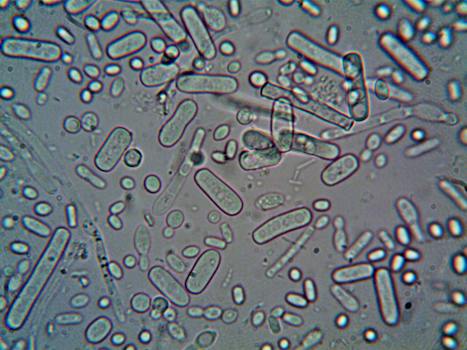-
Table of Contents
- The Harmful Effects of Microorganisms
- Types of Harmful Microorganisms
- Bacteria
- Viruses
- Fungi
- Protozoa
- Health Effects of Harmful Microorganisms
- Infections
- Food Poisoning
- Respiratory Illnesses
- Skin Infections
- Environmental Impact of Harmful Microorganisms
- Contaminating Water Sources
- Causing Crop Diseases
- Contributing to Air Pollution
- Preventing Harmful Microorganisms
- Practicing Good Hygiene
- Cooking Food Thoroughly
- Using Clean Water Sources
- Keeping Environments Clean and Dry
- Conclusion
- Q&A
- 1. What are some common types of harmful microorganisms?
- 2. How can harmful microorganisms affect our health?
- 3. What are some ways to prevent the harmful effects of microorganisms?
- 4. How do microorganisms impact the environment?
- 5. What are some examples of harmful microorganisms?

Microorganisms are tiny living organisms that are invisible to the naked eye. While many microorganisms are harmless or even beneficial, some can have harmful effects on humans, animals, and the environment. In this article, we will explore the various ways in which microorganisms can cause harm and the impact they can have on our health and well-being.
Types of Harmful Microorganisms
There are several types of harmful microorganisms that can cause a range of health issues. Some of the most common types include:
- Bacteria
- Viruses
- Fungi
- Protozoa
Bacteria
Bacteria are single-celled organisms that can cause infections and diseases in humans and animals. Some common bacterial infections include:
- Staphylococcus aureus
- Salmonella
- E. coli
Viruses
Viruses are even smaller than bacteria and can only reproduce inside living cells. They can cause a wide range of illnesses, from the common cold to more serious diseases like HIV and COVID-19.
Fungi
Fungi are a type of microorganism that includes molds and yeasts. They can cause infections in humans, such as athlete’s foot and yeast infections.
Protozoa
Protozoa are single-celled organisms that can cause diseases like malaria and giardiasis. They are often transmitted through contaminated water or food.
Health Effects of Harmful Microorganisms
The harmful effects of microorganisms on our health can be significant. Some of the most common health issues caused by microorganisms include:
- Infections
- Food poisoning
- Respiratory illnesses
- Skin infections
Infections
Bacterial and viral infections can cause symptoms like fever, cough, and fatigue. In severe cases, they can lead to complications like pneumonia or sepsis.
Food Poisoning
Foodborne illnesses caused by bacteria like Salmonella and E. coli can result in symptoms like nausea, vomiting, and diarrhea. In severe cases, they can be life-threatening.
Respiratory Illnesses
Viruses like influenza and respiratory syncytial virus (RSV) can cause respiratory illnesses like the flu and bronchiolitis. These illnesses can be especially dangerous for young children and older adults.
Skin Infections
Fungal and bacterial infections can cause skin conditions like athlete’s foot, ringworm, and impetigo. These infections can be itchy, painful, and unsightly.
Environmental Impact of Harmful Microorganisms
Microorganisms can also have a significant impact on the environment. Some ways in which they can harm the environment include:
- Contaminating water sources
- Causing crop diseases
- Contributing to air pollution
Contaminating Water Sources
Microorganisms like bacteria and protozoa can contaminate water sources, leading to waterborne diseases like cholera and dysentery. This can have serious consequences for public health.
Causing Crop Diseases
Fungal and bacterial pathogens can infect crops, leading to reduced yields and economic losses for farmers. Some common crop diseases caused by microorganisms include blight and powdery mildew.
Contributing to Air Pollution
Microorganisms can release volatile organic compounds (VOCs) that contribute to air pollution. This can have negative effects on human health and the environment, leading to respiratory issues and environmental damage.
Preventing Harmful Microorganisms
There are several ways to prevent the harmful effects of microorganisms, including:
- Practicing good hygiene
- Cooking food thoroughly
- Using clean water sources
- Keeping environments clean and dry
Practicing Good Hygiene
Washing your hands regularly, covering your mouth when you cough or sneeze, and avoiding close contact with sick individuals can help prevent the spread of harmful microorganisms.
Cooking Food Thoroughly
Cooking food to the proper temperature can kill harmful bacteria and viruses that may be present. It is important to follow food safety guidelines to prevent foodborne illnesses.
Using Clean Water Sources
Drinking clean, safe water is essential for preventing waterborne diseases caused by microorganisms. Boiling water or using water purification methods can help ensure its safety.
Keeping Environments Clean and Dry
Regularly cleaning and disinfecting surfaces, especially in high-traffic areas, can help prevent the spread of harmful microorganisms. Keeping environments dry can also help prevent mold growth.
Conclusion
Microorganisms can have harmful effects on our health and the environment, causing infections, food poisoning, respiratory illnesses, and environmental damage. By practicing good hygiene, cooking food thoroughly, using clean water sources, and keeping environments clean and dry, we can help prevent the spread of harmful microorganisms and protect ourselves and our communities.
Q&A
1. What are some common types of harmful microorganisms?
Some common types of harmful microorganisms include bacteria, viruses, fungi, and protozoa.
2. How can harmful microorganisms affect our health?
Harmful microorganisms can cause infections, food poisoning, respiratory illnesses, and skin infections.
3. What are some ways to prevent the harmful effects of microorganisms?
Practicing good hygiene, cooking food thoroughly, using clean water sources, and keeping environments clean and dry can help prevent the spread of harmful microorganisms.
4. How do microorganisms impact the environment?
Microorganisms can contaminate water sources, cause crop diseases, and contribute to air pollution, leading to environmental damage.
5. What are some examples of harmful microorganisms?
Examples of harmful microorganisms include Salmonella bacteria, influenza viruses, and Aspergillus fungi.






